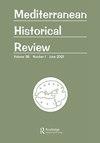Chiselled in rock, printed on paper: Francesco Quaresmio and the epigraphy of the Holy Land
IF 0.2
2区 历史学
Q1 HISTORY
引用次数: 0
Abstract
The substantial two-volume work Terrae Sanctae Elucidatio (1639) by the Franciscan friar Francesco Quaresmio (b. Lodi, Italy, 1583–1656) is known as a veritable encyclopaedia on the Holy Land. It is also an itinerary of pilgrimage through the sacred sites, taking their monumentality and graphic landscape into account. Quaresmio was especially attentive to the Latin inscriptions made by the Crusaders, here copied by him as autoptic testimonies. This is part of a more general phenomenon. From the fifteenth century through to the seventeenth, in Europe this period is sometimes called the “Age of Inscriptions”, during which epigraphy was recognized as a source of ancient history on a par with philology and archaeology. The overall aim of the present article is to show how Quaresmio, while continuing a medieval tradition of Franciscan scholarship, improved upon epigraphical study by deploying a specific technology, namely the visual rendering of uncial inscriptions in printed form. His rigorous observations, however, would have come to naught without the technical mastery of the Flemish printer-typographer Balthasar Moretus (1574–1641). Following previous developments in pilgrimage literature, where inscriptions – especially the Crusader epitaphs at the foot of Calvary – were commonplace, Quaresmio studied inscriptions not only as texts, but also considered their formal and material aspects. Ultimately, the present study argues that these Latin epigraphic texts played a role in the man’s theological argumentation and in the defence of the loca sancta as Latin possession.凿在岩石上,印在纸上:弗朗切斯科-夸雷斯密奥与圣地书法
方济会修士弗朗切斯科-夸雷斯密奥(Francesco Quaresmio,生于意大利洛迪,1583-1656 年)的两卷本巨著《Terrae Sanctae Elucidatio》(1639 年)是一部名副其实的圣地百科全书。它也是一条圣地朝圣路线,考虑到了圣地的纪念性和图形景观。夸雷斯密奥特别关注十字军所作的拉丁文碑文,他将这些碑文抄录在书中作为自证。这是更普遍现象的一部分。从 15 世纪到 17 世纪,在欧洲,这一时期有时被称为 "铭文时代",在此期间,书法被视为与文字学和考古学同等重要的古代历史资料。本文的总体目标是说明夸雷斯密奥如何在继承中世纪方济各会学术传统的同时,通过采用一种特殊技术(即以印刷形式直观呈现斜体碑文)改进了书法研究。然而,如果没有佛兰德印刷排版师巴尔塔萨-莫雷图斯(Balthasar Moretus,1574-1641 年)的精湛技术,他的严谨观察将一无所获。此前,朝圣文学中的碑文--尤其是髑髅地脚下的十字军墓志铭--已司空见惯,夸雷斯密奥不仅将碑文作为文本进行研究,还对其形式和材料方面进行了考量。最终,本研究认为,这些拉丁文书信文本在该人的神学论证和捍卫作为拉丁属地的圣地(loca sancta)方面发挥了作用。
本文章由计算机程序翻译,如有差异,请以英文原文为准。
求助全文
约1分钟内获得全文
求助全文

 求助内容:
求助内容: 应助结果提醒方式:
应助结果提醒方式:


